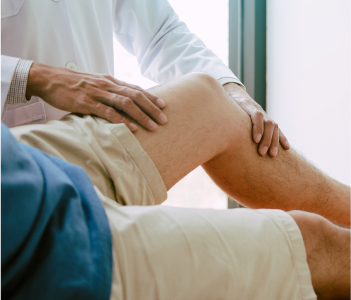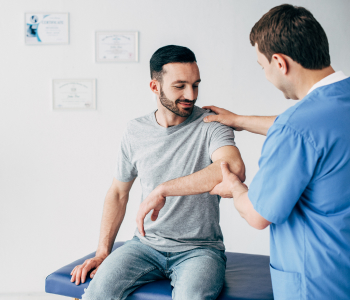Tendon Injuries
Learn about tendon injuries and how your provider at Austin Orthopedic Institute can help.
the numbers
Tendon Injury Statistics.
There are over 33 million musculoskeletal injuries reported annually – and that’s just in the United States! Additionally, over 50% of these injuries involve tendons and ligaments. It’s safe to say that these injuries are very common, and the providers at Austin Orthopedic Institute are here to help you in any way they can.
About Tendon Injuries
Tendon injuries are extremely common in orthopedics. Some of the most common tendon injuries, among others, include:
- Rotator cuff tears
- Biceps tendon tears
- Ankle sprains
- Achilles tendon tears
- Tennis elbow
- Quadriceps and patellar tendon tears
- ACL tears
- MCL tears

Tendon Injuries Can Happen at Any Age
Tendon injuries can affect individuals of any age, though the causes tend to be different.
Young patients typically require a very large force or significant event (such as a severe fall or a sports injury) to cause a complete tear. For a partial tear, young patients typically require repetitive long-term overuse, such as pitching or playing tennis, to result in injury.
Older patients can sustain a complete tendon tear simply as a result of daily activities or a simple fall. Therefore, a low index of suspicion is needed for significant pain or disability in middle aged and older patients who have sustained an injury. Missing a rotator cuff tear can result in the injury progressing from very easily fixed to inoperative.
The difference between the two age groups is the quality of the tissue, which deteriorates as we age, and therefore tears more easily.
Diagnosis & Treatment
How We Diagnose Tendon Injuries
Physical exam findings will often be sufficient to diagnose a tear such as a balled up (popeye deformity) biceps tendon or tendon gap that is palpable at the Achilles or patellar tendon. In some cases, an MRI is required to better visualize the tendon and diagnose, such as cases of hamstring tears or partial biceps tendon tears.
In the instance of tendon injuries, X-rays cannot be used as diagnostic tools, as they do not have the capability to visualize tendons.
It is important for the surgeon to take in account the anatomic location, severity/size, chronicity (how long ago the tear occurred), age, and activity level of the patient. Generally speaking, the best prognosis is found in younger patients with small and acute tears.
Treating Tendon Injuries
The clinical effect of tendon tears varies widely depending on the location of the injury. For instance, many biceps tendon tears at the shoulder can be treated nonoperatively in older patients with very little disability and usually no pain. However, a complete patellar tendon rupture must be surgically repaired in order to regain function. In all cases, a complete tear will not repair itself. Either surgical intervention is required, or the patient is rehabbed to accommodate for the deficit.
Every patient and every tendon tear is different, requiring an experienced orthopedic surgeon to help guide decision making about treatment and to implement cutting-edge surgical technique when surgery is indicated.
Let Austin Orthopedic Institute Help
The providers at Austin Orthopedic Institute are experienced in treating and upholding the highest standard of patient care when it comes to tendon injuries. Austin Orthopedic Institute provides top-tier care, and keeps you informed – from diagnosis, to creating a customized treatment plan that will restore your function to its greatest capacity, to intervention and treatment (whether it be surgical or non-surgical).




